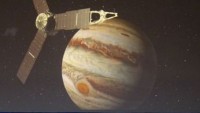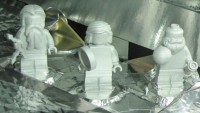Juno Probe Successfully Enters the Orbit of Jupiter
| Arthur Dominic Villasanta | | Jul 05, 2016 02:36 AM EDT |
(Photo : NASA/JPL/Caltech) Juno firing its main engine during Jupiter orbital insertion (illustration)
At 11:54 pm Eastern, loud applause and cheers echoed throughout NASA's Jet Propulsion Laboratory (JPL) after data confirmed the mammoth solar-powered Juno spacecraft had successfully entered the orbit of Jupiter on the 4th of July as planned.
"Welcome to Jupiter!" lit up mission control screens at JPL in Pasadena, California. A tweet from NASA's Juno Mission read "Engine burn complete and orbit obtained. I'm ready to unlock all your secrets, #Jupiter. Deal with it." Google celebrated the event with a special infographic on its search page.
Like Us on Facebook
Scientists now eagerly anticipate the first photos of Jupiter taken by Juno.
The "orbital insertion maneuver" that began at 11:18 pm Eastern slowed down Juno by some 542 meters per second so Jupiter's gravity could capture the speeding spacecraft that blasted-off from Earth on Aug. 5, 2011 and has been chasing Jupiter since. NASA learned about the successful ignition of the probe's engine 49 minutes after the burn took place.
Juno transmitted tones throughout the process. Each tone was a signal for a different milestone but the most important one was the final "I am in orbit" tone they received at 11:54 pm EDT.
Juno, which is an acronym for "JUpiter Near-polar Orbiter," will give scientists their closest look ever of the solar system's largest planet and probably the first planet to be formed in the solar system.
Juno's nine instruments will study Jupiter's composition, gravity field, magnetic field and polar magnetosphere. It will also search for clues about how Jupiter formed; will try to find out if Jupiter has a rocky core and determine the amount of water present its atmosphere, among others.
A NASA video of Juno approaching Jupiter's moons can be viewed here.
"This is phenomenal," said Geoff Yoder, acting administrator for NASA's Science Mission Directorate.
"NASA did it again," said Scott Bolton, Juno principal investigator. "We're there, we're in orbit. We conquered Jupiter."
Juno is a huge spacecraft. Its main spacecraft body measures 3.5 meters tall and 3.5 meters in diameter. With its three solar panels open, however, Juno spans some 20 meters.
Juno will orbit Jupiter 37 times over the next 20 months before it crashes into the planet on February 20, 2018, officially ending this historic mission.
TagsJuno spacecraft, Jupiter, NASA's Jet Propulsion Laboratory, JUpiter Near-polar Orbiter
©2015 Chinatopix All rights reserved. Do not reproduce without permission
EDITOR'S PICKS
-

Did the Trump administration just announce plans for a trade war with ‘hostile’ China and Russia?
-

US Senate passes Taiwan travel bill slammed by China
-

As Yan Sihong’s family grieves, here are other Chinese students who went missing abroad. Some have never been found
-

Beijing blasts Western critics who ‘smear China’ with the term sharp power
-

China Envoy Seeks to Defuse Tensions With U.S. as a Trade War Brews
-

Singapore's Deputy PM Provides Bitcoin Vote of Confidence Amid China's Blanket Bans
-

China warns investors over risks in overseas virtual currency trading
-

Chinese government most trustworthy: survey
-

Kashima Antlers On Course For Back-To-Back Titles
MOST POPULAR
LATEST NEWS
Zhou Yongkang: China's Former Security Chief Sentenced to Life in Prison

China's former Chief of the Ministry of Public Security, Zhou Yongkang, has been given a life sentence after he was found guilty of abusing his office, bribery and deliberately ... Full Article
TRENDING STORY

China Pork Prices Expected to Stabilize As The Supplies Recover

Elephone P9000 Smartphone is now on Sale on Amazon India

There's a Big Chance Cliffhangers Won't Still Be Resolved When Grey's Anatomy Season 13 Returns

Supreme Court Ruled on Samsung vs Apple Dispute for Patent Infringement

Microsoft Surface Pro 5 Rumors and Release Date: What is the Latest?













